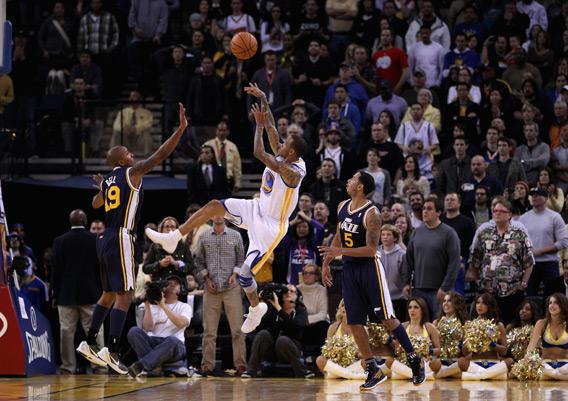It’s impossible to talk about the NBA this season without talking about the impact of the lockout-induced shortening of the season. Right now, the no-star Denver Nuggets have a better record than the storied Lakers? Must be because the dense schedule rewards deep teams with young legs. The equally lackluster Philadelphia 76ers going toe-to-toe with Miami and Chicago? Thank roster continuity, surely a strong source of advantage in a season without training camp. But what about the quality of play writ large? Is Charles Barkley right to think the league needs to apologize to its fans? How would we even know?
Probably the last thing we should do is trust our casual impressions of the season thus far. The fact is that there have always been a lot of lousy NBA teams. It’s easy to get hung up on this year’s sucky Wizards and Bobcats while letting the warm haze of Kyrie Irving and Ricky Rubio blind us to the sucky Cavaliers and Timberwolves of the previous season. We remember the great games and the stellar matchups and tend to forget the rest. But this year the tug of nostalgia points toward the truth: The players really have gotten worse.
You can see this most clearly in the precipitous drop in scoring. For the past four seasons the league as a whole has been remarkably consistent. The average team scored 99.9 points per game in 2007-08, 100 in 2008-09, 100.4 in 2009-10, and 99.6 in 2010-11. This year the streak of 100-point averages has come to a thundering halt, with scoring down to 94.6 points per game. We haven’t seen a number that low since the 2003-04 season. But even that’s a bit misleading. Teams were playing at a slower pace eight years ago, which naturally depresses scoring. This year the pace has declined a little from what we saw last season, but the main reason scoring has dropped is because guys can’t hit shots. Field goal percentage has declined from .459 to .443 and three-point shooting has dropped from .358 to .345.
In principle, that could be better defense rather than worse offense. But good defense can’t explain why free-throw percentage is down to .747 from last season’s .763—that’s player incompetence, caught red-handed.
Free throws alone, of course, can’t explain the entirety of the decline in scoring. Nor is the 1.6 percentage point difference likely to be something fans even notice by eyeballing. But I don’t think it’s unreasonable to view it as evidence of a broader decline in shooting prowess. Accuracy from the charity stripe was a bit worse in 2006, but shooters made up for it that year with a torrid .358 from beyond the three-point arc. That one exception aside, the most recent year with worse free-throw shooting was the 1999 season. That year, of course, was also shortened by a lockout and—just like this year—involved a general decline in scoring and shooting ability. Some combination of fatigue and reduced playing time for the best players really does seem to have degraded the league’s average skill level. The decrease in minutes is a subtle thing, but important. Most stars—Derrick Rose, LeBron James, Kevin Durant—are playing less as their coaches try to keep them fresh. And when they are on the floor, players are faced with more frequent back-to-back games and a dizzying travel schedule.
The damage is also visible in terms of turnovers. So far this year, 14.2 percent of plays have ended in turnovers. The previous two seasons, only five teams were that bad at controlling possession.
But here’s the wrinkle: The audience is loving it. NBA ratings are up. Way up. As of Feb. 2, viewership on regional cable was up 12 percent, on ESPN it was up 23 percent, over-the-air broadcasts up 36 percent, NBA on TNT up 50 percent, and NBA TV viewership was enjoying a 66 percent increase in ratings.
It’d be a stretch to argue that lower quality play is driving the higher ratings, but perhaps not so implausible to think that the compressed schedule makes the league more appealing. The NBA’s typical start time—roughly the end of October—leaves it languishing in irrelevance for months, overshadowed by football. This year’s Christmas Day start let basketball duck the college football season and gear up just as the NFL was winding down. Games naturally take on more urgency when there are fewer of them. But greater game density, as such, seems to make the NBA as a whole more exciting. Most crudely, the more games that are on any given night the more likely that there’ll be at least one really memorable moment for the next day’s SportsCenter. Whether that’s Blake Griffin’s monstrous dunk on Kendrick Perkins or Harvard-educated Taiwanese-American point guard Jeremy Lin’s sudden emergence as a scoring threat, more games per evening means better odds that something interesting will happen. Tuesday night’s list of games lacked any real marquee matchups, but of the six games, four were close. One, the not-very-promising matchup of the Oklahoma City Thunder against the drastically inferior Golden State Warriors turned out to be a nail-biter featuring the career-best performance of Monta Ellis.
Notwithstanding the woeful state of the Wizards, I can’t remember an NBA regular season this engaging. If a small decline in the quality of play is the price we need to pay to get a shorter, denser, more action-packed season each and every year, then I’m all for it. So Barkley is right, the players aren’t performing. But he is wrong to say the NBA should apologize for it. Instead, the league should be working to repeat it and find a way to make a shorter, denser schedule the new normal.
